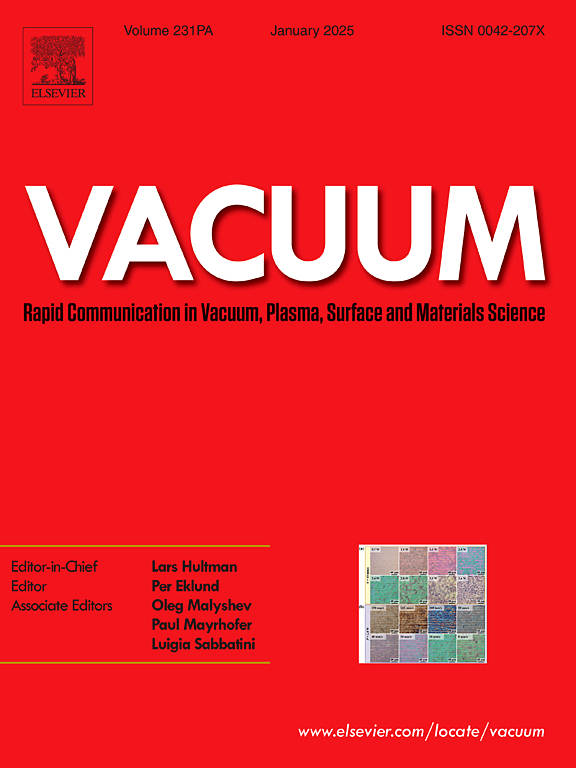Defect engineering of anchored on F-doped BNNR surface to enhance low-frequency microwave absorption and achieve exceptional thermal conductivity properties
IF 3.8
2区 材料科学
Q2 MATERIALS SCIENCE, MULTIDISCIPLINARY
引用次数: 0
Abstract
The growing demand for AI and smart computing drives the development of compact, lightweight electronic products to mitigate electromagnetic wave (EMW) pollution and thermal management issues. This necessitates materials with enhanced microwave absorption (MA) and optimal thermal conductivity (TC). Herein, we designed and synthesized fluorinated boron nitride nanorods (F-BNNRs) in a single step via plasma ball milling. Ammonium fluoride (NH₄F) served as the fluorinating agent for hexagonal boron nitride nanorods (h-BNNRs). F-BNNR3, with a NH₄F to h-BNNR ratio of 10:1 and 5.84 % fluorine (F) content, exhibits excellent MA, achieving a minimum reflection loss (RLmin) of −68.56 dB at 5.14 GHz with a thickness of 4.32 mm. It also displays a broad MA frequency range (4.6–6.1 GHz, 15.4–17.2 GHz) with significant RL < −10 dB. Additionally, a 0.09 wt% F-BNNR3 solution achieves a thermal conductivity (TC) of 0.95 W m⁻1K⁻1, 134 % higher than that of a 0.09 wt% h-BNNR dispersion fluid. Following a post-static treatment, F-BNNR3 attains a TC of 0.86 W m⁻1K⁻1, 118 % higher than that of h-BNNR. The incorporation of F into h-BNNRs significantly enhances MA and TC performance, addressing EMW pollution and thermal management challenges in advanced communication technologies utilizing nanofluids.
锚定在掺杂 F 的 BNNR 表面的缺陷工程,可增强低频微波吸收并实现优异的导热性能
对人工智能和智能计算日益增长的需求推动了紧凑型轻质电子产品的发展,以减轻电磁波(EMW)污染和热管理问题。这就要求材料具有更强的微波吸收能力(MA)和最佳的热导率(TC)。在此,我们通过等离子体球磨一步法设计并合成了氟化氮化硼纳米棒(F-BNNRs)。氟化铵(NH₄F)是六方氮化硼纳米棒(h-BNNRs)的氟化剂。F-BNNR3 的 NH₄F 与 h-BNNR 的比例为 10:1,氟(F)含量为 5.84%,具有出色的 MA 性能,在 5.14 GHz 频率下,厚度为 4.32 mm 时的最小反射损耗(RLmin)为 -68.56 dB。它还显示出宽广的 MA 频率范围(4.6-6.1 GHz、15.4-17.2 GHz),RL < -10 dB。此外,0.09 wt% F-BNNR3 溶液的热导率 (TC) 达到 0.95 W m-1K-1,比 0.09 wt% h-BNNR 分散液的热导率高 134%。经过后静态处理后,F-BNNR3 的导热系数为 0.86 W m-1K-1,比 h-BNNR 高 118%。在 h-BNNR 中加入 F 可显著提高 MA 和 TC 性能,从而解决利用纳米流体的先进通信技术中的电磁波污染和热管理难题。
本文章由计算机程序翻译,如有差异,请以英文原文为准。
求助全文
约1分钟内获得全文
求助全文
来源期刊

Vacuum
工程技术-材料科学:综合
CiteScore
6.80
自引率
17.50%
发文量
0
审稿时长
34 days
期刊介绍:
Vacuum is an international rapid publications journal with a focus on short communication. All papers are peer-reviewed, with the review process for short communication geared towards very fast turnaround times. The journal also published full research papers, thematic issues and selected papers from leading conferences.
A report in Vacuum should represent a major advance in an area that involves a controlled environment at pressures of one atmosphere or below.
The scope of the journal includes:
1. Vacuum; original developments in vacuum pumping and instrumentation, vacuum measurement, vacuum gas dynamics, gas-surface interactions, surface treatment for UHV applications and low outgassing, vacuum melting, sintering, and vacuum metrology. Technology and solutions for large-scale facilities (e.g., particle accelerators and fusion devices). New instrumentation ( e.g., detectors and electron microscopes).
2. Plasma science; advances in PVD, CVD, plasma-assisted CVD, ion sources, deposition processes and analysis.
3. Surface science; surface engineering, surface chemistry, surface analysis, crystal growth, ion-surface interactions and etching, nanometer-scale processing, surface modification.
4. Materials science; novel functional or structural materials. Metals, ceramics, and polymers. Experiments, simulations, and modelling for understanding structure-property relationships. Thin films and coatings. Nanostructures and ion implantation.
 求助内容:
求助内容: 应助结果提醒方式:
应助结果提醒方式:


